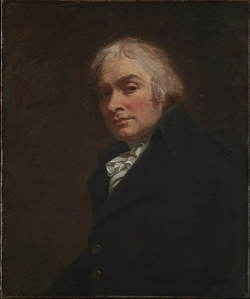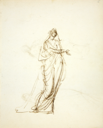George Romney
British, (1734–1802)
George Romney was the third of eleven children born to John Romney and Anne Simpson. Leaving school at the age of eleven, he worked for eight years in his father's cabinetmaking workshop before being apprenticed to a local painter, Christopher Steele, with whom he served for two years, from 1755 to 1757, in Kendal, York, and Lancaster. He married a Kendal girl, Mary Abbot, on 14 October 1756, and painted at Kendal from 1756 to 1762, principally small full-length portraits. In 1762 Romney settled in London, leaving his wife and son behind, and henceforward saw them only on his few visits to the north. He won premiums for his historical paintings from the Society of Arts in 1763 and 1765, and exhibited at the Free Society between 1763 and 1769, and with the Society of Artists from 1770 to 1772. During a visit to Paris in the autumn of 1764 he was deeply impressed by the classicism of Eustache Le Sueur. His portraits were chiefly influenced by Ramsay. In 1773 he traveled to Italy with the miniaturist Ozias Humphry, remaining there until 1775, chiefly in Rome. On his return to London Romney was patronized by the Duke of Richmond, in whose celebrated gallery of casts he had formerly studied, and took the grand house in Cavendish Square, with its large painting room, previously occupied by Francis Cotes. He achieved an instant success, and his unremitting application as a society portraitist is amply documented by his sitter books, which survive for the years 1776 to 1795. He never bothered to exhibit at the Royal Academy of Arts, though this was partly due to an antagonism with Reynolds. His health affected by overapplication, he gave up portrait painting at the end of 1795 and retired to Hampstead. In 1798 he sold the lease of his London house and returned to Kendal, where he died insane on 15 November 1802.
Source: National Gallery of Art, Washington, DC
British, (1734–1802)
George Romney was the third of eleven children born to John Romney and Anne Simpson. Leaving school at the age of eleven, he worked for eight years in his father's cabinetmaking workshop before being apprenticed to a local painter, Christopher Steele, with whom he served for two years, from 1755 to 1757, in Kendal, York, and Lancaster. He married a Kendal girl, Mary Abbot, on 14 October 1756, and painted at Kendal from 1756 to 1762, principally small full-length portraits. In 1762 Romney settled in London, leaving his wife and son behind, and henceforward saw them only on his few visits to the north. He won premiums for his historical paintings from the Society of Arts in 1763 and 1765, and exhibited at the Free Society between 1763 and 1769, and with the Society of Artists from 1770 to 1772. During a visit to Paris in the autumn of 1764 he was deeply impressed by the classicism of Eustache Le Sueur. His portraits were chiefly influenced by Ramsay. In 1773 he traveled to Italy with the miniaturist Ozias Humphry, remaining there until 1775, chiefly in Rome. On his return to London Romney was patronized by the Duke of Richmond, in whose celebrated gallery of casts he had formerly studied, and took the grand house in Cavendish Square, with its large painting room, previously occupied by Francis Cotes. He achieved an instant success, and his unremitting application as a society portraitist is amply documented by his sitter books, which survive for the years 1776 to 1795. He never bothered to exhibit at the Royal Academy of Arts, though this was partly due to an antagonism with Reynolds. His health affected by overapplication, he gave up portrait painting at the end of 1795 and retired to Hampstead. In 1798 he sold the lease of his London house and returned to Kendal, where he died insane on 15 November 1802.
Source: National Gallery of Art, Washington, DC
Artist Objects
Mrs. Yates as the Tragic Muse 1982.011


